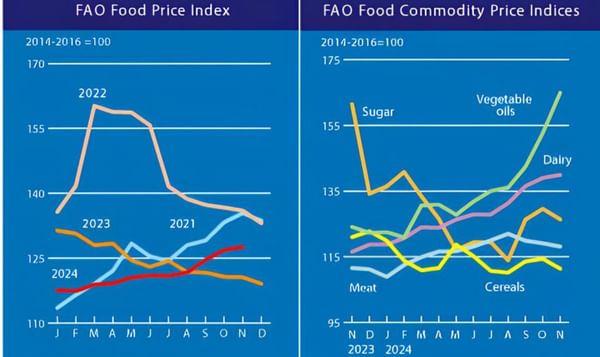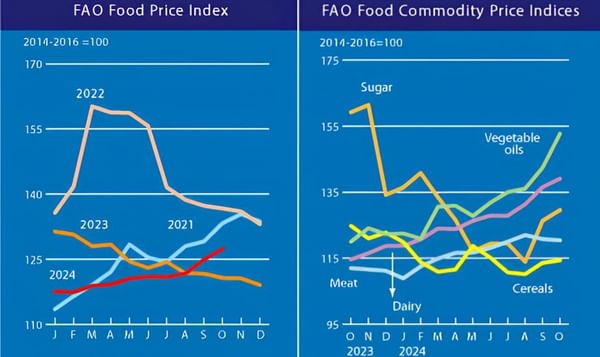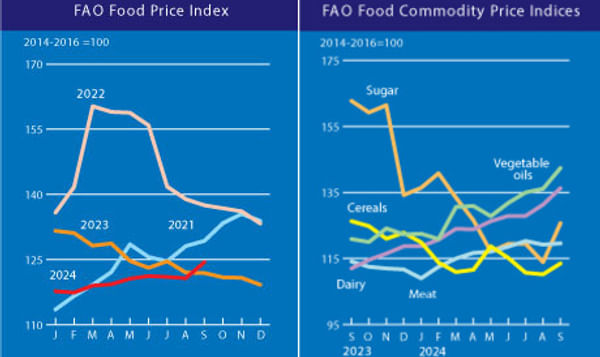The FAO Food Price Index (FFPI) averaged 176.4 points in October 2017, down 2.2 points (1.3 percent) from September. With the exception of cereals, all the indices contributed to the decline in October
FAO Food Price Index down slightly in October

The FAO Food Price Index (FFPI) averaged 176.4 points in October 2017, down 2.2 points (1.3 percent) from September. Although at this level the FFPI was up 4 points (2.5 percent) from its value in October 2016, it remained 27 percent below its all-time high (in nominal terms) of 240 points registered in February 2011. With the exception of cereals, all the other indices used in the calculation of the FFPI fell in October.
The FAO Cereal Price Index averaged 152.8 points in October, up a notch from September and 10.5 points (7.4 percent) higher than the same month last year. Among the major cereals, wheat quotations were generally lower, pressured by large exportable supplies from the Back Region and increased competition among exporters. Maize prices increased slightly in the US, although those from South America were weighed down by large supplies. Rice prices strengthened in October, amid seasonally tight Japonica and fragrant supplies, with additional support for Japonica prices stemming from a series of tenders in the Far East.
The FAO Vegetable Oil Price Index averaged 170 points in October, down 1.8 points (or 1.1 percent) compared to the previous month and close to the level recorded one year ago. The index’ retreat was primarily driven by palm and soy oils. Palm oil values weakened on higher than anticipated inventory levels in Malaysia and the expectation of production gains in Southeast Asia, while soyoil prices eased on good soybean harvest progress in the United States and forecasts of ample global availabilities in 2017/18. Lower sunflower oil quotations, facilitated by large export availabilities in the Black Sea region, also weighed on the index.
The FAO Dairy Price Index averaged 214.8 points in October, down 9.4 points (4.2 percent) from September and marking the first drop since May 2017. At that level, the index was 32 points (17.5 percent) above its value in October 2016, but 22 percent below its peak reached in February 2014. International quotations for butter, skim milk powder (SMP) and whole milk powder (WMP) eased in October, while those of cheese remained more stable. Butter and WMP prices fell as importers held back on purchases, awaiting arrival of new supplies from Oceania. Low demand and ample intervention stocks in the EU hastened the decline of SMP prices. A balanced cheese market contributed to more stable cheese quotations.
The FAO Meat Price Index averaged 172.7 points in October, down 1.6 points (0.9 percent) from September and continuing a trend of moderate declines that began in July this year. International prices of pig and ovine meat declined in October, while those of bovine meat increased and of poultry were stable. Intense competition among exporters and sluggish import demand have been behind the declines in pigmeat prices observed in recent months. However, bovine meat prices rose for the third consecutive month due to limited spot offers from Oceania. A seasonal increase in ovine meat supplies in Oceania pushed down ovine prices, while poultry meat markets remained well balanced.
The FAO Sugar Price Index averaged nearly 203 points in October, down 1.4 points (0.7 percent) from September and as much as 112 points, or 36 percent, below the corresponding month last year. Sugar prices fell in October as the potential for higher supplies in 2017/18 was further reinforced with prospects for a larger beet crop in the EU and bigger output in the Russian Federation. Weaker Brazilian Real, increasing the potential for larger export sales from Brazil, also weighed on international prices, especially in view of a significant slowdown in purchases by China because of higher import tariffs.
The FAO Cereal Price Index averaged 152.8 points in October, up a notch from September and 10.5 points (7.4 percent) higher than the same month last year. Among the major cereals, wheat quotations were generally lower, pressured by large exportable supplies from the Back Region and increased competition among exporters. Maize prices increased slightly in the US, although those from South America were weighed down by large supplies. Rice prices strengthened in October, amid seasonally tight Japonica and fragrant supplies, with additional support for Japonica prices stemming from a series of tenders in the Far East.
The FAO Vegetable Oil Price Index averaged 170 points in October, down 1.8 points (or 1.1 percent) compared to the previous month and close to the level recorded one year ago. The index’ retreat was primarily driven by palm and soy oils. Palm oil values weakened on higher than anticipated inventory levels in Malaysia and the expectation of production gains in Southeast Asia, while soyoil prices eased on good soybean harvest progress in the United States and forecasts of ample global availabilities in 2017/18. Lower sunflower oil quotations, facilitated by large export availabilities in the Black Sea region, also weighed on the index.
The FAO Dairy Price Index averaged 214.8 points in October, down 9.4 points (4.2 percent) from September and marking the first drop since May 2017. At that level, the index was 32 points (17.5 percent) above its value in October 2016, but 22 percent below its peak reached in February 2014. International quotations for butter, skim milk powder (SMP) and whole milk powder (WMP) eased in October, while those of cheese remained more stable. Butter and WMP prices fell as importers held back on purchases, awaiting arrival of new supplies from Oceania. Low demand and ample intervention stocks in the EU hastened the decline of SMP prices. A balanced cheese market contributed to more stable cheese quotations.
The FAO Meat Price Index averaged 172.7 points in October, down 1.6 points (0.9 percent) from September and continuing a trend of moderate declines that began in July this year. International prices of pig and ovine meat declined in October, while those of bovine meat increased and of poultry were stable. Intense competition among exporters and sluggish import demand have been behind the declines in pigmeat prices observed in recent months. However, bovine meat prices rose for the third consecutive month due to limited spot offers from Oceania. A seasonal increase in ovine meat supplies in Oceania pushed down ovine prices, while poultry meat markets remained well balanced.
The FAO Sugar Price Index averaged nearly 203 points in October, down 1.4 points (0.7 percent) from September and as much as 112 points, or 36 percent, below the corresponding month last year. Sugar prices fell in October as the potential for higher supplies in 2017/18 was further reinforced with prospects for a larger beet crop in the EU and bigger output in the Russian Federation. Weaker Brazilian Real, increasing the potential for larger export sales from Brazil, also weighed on international prices, especially in view of a significant slowdown in purchases by China because of higher import tariffs.
Like to receive news like this by email? Join and Subscribe!
Join Our Telegram Channel for regular updates!
Highlighted Company
Sponsored Content
Sponsored Content
Sponsored Content
Sponsored Content
Sponsored Content











